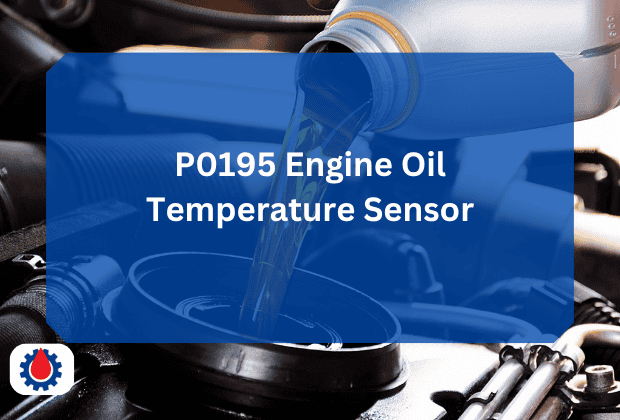When this sensor fails, the onboard diagnostic system triggers a P0195 trouble code. If you’re seeing this code, don’t panic, it’s a common issue and often fixable without major expense. In this post, we’ll break down what the P0195 code means, symptoms you might notice, causes, how to diagnose it, and possible solutions.
P0195 Engine Oil Temperature Sensor
The P0195 diagnostic trouble code is defined as Engine Oil Temperature Sensor Circuit Malfunction.
This code appears when the powertrain control module (PCM) detects an irregular voltage signal from the engine oil temperature sensor. This sensor typically uses a thermistor (a resistor that changes with temperature) to provide the PCM with real-time data on oil temperature.
The PCM uses this data to make decisions about fuel delivery, ignition timing, and even variable valve timing. Incorrect readings due to sensor failure or circuit issues can lead to poor engine performance or damage over time.
Common Symptoms of a P0195 Code
When your vehicle throws a P0195 code, you might notice one or more of the following signs:
- Illuminated Check Engine Light (CEL)
- Poor fuel economy
- Hard starting or long cranking time
- Rough idle or engine misfires
- Reduced power or limp mode activation
- Engine overheating or incorrect temperature readings
- Delayed or improper gear shifting (in automatic transmissions)
Note that the symptoms may vary depending on the make and model of the vehicle, as well as whether the sensor has failed completely or is giving intermittent readings.
Related Engine Oil Pressure Control Circuit Stuck On(6 Causes + Solutions)
What Causes Code P0195?
A P0195 code can be triggered by several underlying problems. Some of the most common include:
- Faulty engine oil temperature sensor
- Damaged or corroded wiring and connectors
- Open or short circuit in the sensor wiring
- Bad ground connection
- Faulty powertrain control module (rare)
- Sensor connector not fully seated or contaminated
In many cases, it’s not the sensor itself but a damaged wire or corroded plug that’s to blame.
Related Can Low Oil Cause Check Engine Light(Explained)
How to Diagnose a P0195 Code
To accurately diagnose and repair a P0195 error, follow these steps:
- Scan the ECU
- Use an OBD-II scanner to confirm the code. Check for any additional codes that might help identify related issues.
- Visual Inspection
- Locate the engine oil temperature sensor (often found near the oil filter housing or in the oil pan).
- Inspect the wiring harness for cracks, frays, or signs of rodent damage.
- Look at the sensor connector for corrosion, bent pins, or loose connections.
- Check Sensor Resistance
- Remove the sensor and test it with a multimeter.
- At room temperature, a working sensor typically shows around 2,500–3,000 ohms (consult your vehicle’s service manual for exact specs).
- Warm the sensor (e.g., in hot water) and see if the resistance drops accordingly. No change or erratic readings indicate failure.
- Test Voltage from PCM
- Backprobe the sensor connector with the ignition on.
- Most sensors should receive a 5V reference signal. If this is absent, you may have a PCM or wiring issue.
- Check Engine Oil Condition
- Old or sludgy oil may cause the sensor to overheat or give false readings.
- Change the oil if it hasn’t been serviced recently.
Related Does Service Engine Soon Mean Oil Change(Explained)
How to Fix Code P0195
Here are common repairs based on the cause:
Replace the engine oil temperature sensor
- If the sensor is faulty or gives incorrect resistance readings, replace it with a new OEM or high-quality aftermarket part.
Repair or replace damaged wiring
- Use heat-shrink tubing or solder connections to restore proper continuity and insulation.
Clean or replace the sensor connector
- A corroded or dirty plug can lead to false signals. Use electrical contact cleaner or replace the plug if needed.
Update or reflash PCM software (rare)
- In very rare cases, a software glitch might be resolved by updating your vehicle’s PCM through a dealership.
Related SBC Engine Oil Cooler Kit(Top 5 Best 2025)
Can You Drive with a P0195 Code?
In most cases, yes, you can drive your vehicle with a P0195 code, but it’s not ideal. The engine may compensate by using preset oil temperature values (limp mode), which can lead to poor fuel economy, rough performance, or overheating. If ignored for too long, it could cause engine wear due to improper lubrication or misfires.
If the check engine light is flashing or the vehicle exhibits severe symptoms (e.g., overheating, hard starting), stop driving and have it checked immediately.
Preventive Maintenance Tips
- Change your engine oil regularly according to your manufacturer’s recommendations.
- Inspect and clean engine bay wiring periodically, especially if you live in areas with harsh winters or rodent activity.
- Use high-quality oil and filters to avoid sludge buildup and overheating.
- Address any check engine lights promptly, minor issues can become major if neglected.
Related ASM Engine Oil Quick Reference Chart(Complete Guide)
FAQs
What happens when an oil temperature sensor goes bad?
When the oil temperature sensor fails, it can send inaccurate or no data to the engine control module. This may cause poor engine performance, reduced fuel efficiency, incorrect ignition timing, hard starts, or even engine overheating. In some vehicles, it can trigger limp mode to protect the engine.
How to fix P0195 code?
To fix a P0195 code:
- Inspect and repair damaged wiring or connectors
- Test and replace the faulty oil temperature sensor if necessary
- Check for proper voltage and ground supply to the sensor
- Clear the code with an OBD-II scanner after the repair
- If the issue persists, further diagnostic steps may involve checking the PCM
What are the symptoms of transmission oil temperature sensor?
Symptoms of a faulty transmission oil temperature sensor may include:
- Harsh or delayed gear shifting
- Transmission slipping or overheating
- Limp mode activation
- Poor fuel efficiency
- Illuminated check engine or transmission warning light
Where is the oil temperature sensor located?
The oil temperature sensor is typically located near the oil filter housing, on the oil cooler, or in the oil pan, depending on the vehicle model. Consult the vehicle’s service manual for the exact location.
Can I drive with a faulty temperature sensor?
You can drive short distances with a faulty oil temperature sensor, but it’s not recommended for the long term. Incorrect oil temperature readings can affect fuel injection, ignition timing, and engine protection systems, potentially leading to engine damage if left unresolved.
Final Thoughts
The P0195 engine oil temperature sensor malfunction code is a manageable issue when approached systematically. Whether it’s a simple wiring repair or sensor replacement, addressing it promptly helps preserve engine performance and prevent costly repairs down the road. If you’re not comfortable performing the diagnostics yourself, a qualified mechanic can usually fix the issue within a few hours.




